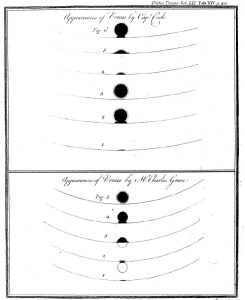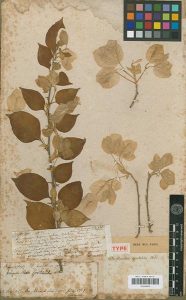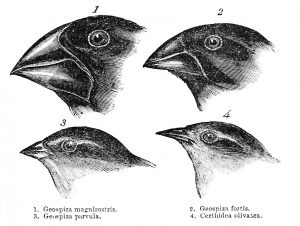6 Science, and the Pacific’s role in European thought
The number of European expeditions entering the Pacific increased markedly towards the end of the 1700s, and there was a notable shift in both the objectives and methods of European exploration of the region. Europe was going through a period of significant change, and science was taking up a prominent role in European thinking, a role it still holds. European science shaped exploration of the Pacific, and the Pacific shaped significant aspects of European science. The Pacific offered a region for study, became a laboratory, and played a major role in European thinking about the world.

The start of science-driven exploration of the Pacific is generally associated with the Endeavour voyage. That voyage was sponsored by the Royal Society, an institution established in 1660 that was central to the development of scientific methods and thinking. The Society’s motto ‘Nullius in Verba’ translates as ‘take nobody’s word for it’ and marked a significant shift in thinking as it endorsed observation and experiment (in contrast to tradition and authority) as sources of knowledge. The Society’s journal Philosophical Transactions established the model of peer-reviewed scientific publication that remains central to research to the present day.
Science was at the heart of the Endeavour voyage. One manifestation was in astronomy. The transit of the planet Venus across the sun that was due to occur in 1769 marked an opportunity to calculate the distance between the earth and the sun that would not be repeated for 120 years. The successful calculation of that distance required astronomers to observe and record the transit at widely spaced localities. Samuel Wallis arrived in England with news of Tahiti at the perfect moment for it to be chosen as a site for European scientific observation and to play a role in establishing the earth’s place in the solar system.
The Endeavour carried a range of scientists, among them Cook who was both a skilled astronomer and an excellent cartographer. The expedition also included an astronomer appointed by the Royal Society, Charles Green. Connections between the expedition and the Society also manifested in the person of Joseph Banks. Banks was a wealthy gentleman, a fellow of the Royal Society, and sufficiently influential to join the voyage in the service of science, and to bring a team of artists and scientists with him. In 1778 Banks became president of the Royal Society, a post he held until his death in 1820. In the wake of the Endeavour the advancement of science became a recognised goal of Pacific exploration by European powers.
And the Endeavour’s scientists made significant contributions to Europe’s scientific knowledge. The Endeavour’s astronomers recorded observations of the transit of Venus from two locations in Tahiti, and those observations played a role in the subsequent calculations that determined distances between objects within the solar system. Banks and his scientists collected 30,000 plant specimens, 1,000 animal specimens, and prepared many scientific drawings. Those collections increased the number of the world’s known plants by one quarter. After his return to Europe, Banks acted as a patron of scientific research, and his Pacific collections both advanced European knowledge of the world, and helped Banks establish his position as a scientific gentleman of renown.

England was not the only European state interested in scientific exploration of the Pacific. In 1764 France founded a colony in the Falkland Islands as a place of resupply for ships bound for Asia. The location of the Falkland Islands promised France control over shipping in the south Atlantic, but the islands’ location near the Straits of Magellan quickly made them significant for Pacific exploration. Louis-Antoine de Bougainville was involved in the French settlement of the Falkland Islands, and in conceding their sovereignty to the Spanish in 1767. His 1766-9 voyage first travelled to the Falkland Islands to formally hand them over to Spain, then continued to the Pacific. Bougainville’s voyage combined politics, survey, and science: among those travelling on his two ships were the naturalist Philibert Commerson, and his assistant Jean(ne) Baret. Bougainville’s voyage marked an incomplete shift to science as a rationale for Pacific exploration: Commerson made collections and observations, but he did not represent a formal connection between the voyage and scientific institutions in France. He might better be considered a transition between Pacific science undertaken from personal interest, as exemplified by William Dampier, and the formal science of the Endeavour voyage. Even that shift to formal science was incomplete, and science and politics remain tangled. Staking a claim to scientific aims could allow naval ships to move through regions claimed by other European nations, even while at war as scientific passports were widely, although not universally, respected. In addition, claiming a national interest in advancing science was a source of national prestige, particularly for the British and French.

The Endeavour was followed by many vessels carrying scientists and collecting specimens and observations. The voyage of the Beagle in 1831-6 is famously associated with Charles Darwin and the theory of evolution. Many of the observations that informed Darwin in his development of the theory of evolution by natural selection were made during his time in the Pacific. In particular, the finches he observed in the Galapagos Islands provided an excellent example of adaptive radiation. While Darwin’s theory was controversial when first published, it soon became widely accepted and at the time of his death Darwin was accorded a state funeral. The voyage of the Beagle has its place in European mythology: in 2005 a Mars lander was named Beagle 2 in honour of Darwin’s voyage and in expectation that it too would make significant observations of previously unfamiliar environments. Exemplifying the hazards of exploration, it was destroyed on impact with the Martian surface.
However, the Beagle’s voyage was in the service of cartography, and Darwin’s presence was the result of the captain’s desire to take a companion for the long voyage. Robert Fitzroy feared that loneliness (as captain he was unable to socialise with those of other ranks) might lead him to suicide, and Darwin was present to provide him with conversation. Through Darwin, the Pacific played an important role in formulating European ideas about the natural world, and through Darwin travel became clearly associated with the pursuit of science. However, Darwin’s presence on the Beagle was more a continuation of the tradition of Dampier and the interested observer than a shift to voyages of exploration pursuing explicitly scientific objectives.
The rise of scientific thinking in Europe changed the way Europeans approached the Pacific. Voyages became more frequent (in part because of changes in technology), and more closely linked with national navies and national prestige. Science became an important element of European voyages within the Pacific. As a result of the rise of scientific thinking the Pacific took on a new role in the European imagination—that of a laboratory full of curious and revealing facts. And the Pacific helped Europeans find their place in the solar system, and in the natural world.
Links
Explorer Journals
Banks, Joseph. The Endeavour Journal of Joseph Banks 1768-1771, Volume I. Sydney: The Trustees of the Public Library of New South Wales in association with Angus and Robertson Limited, 1962. http://nzetc.victoria.ac.nz/tm/scholarly/tei-Bea01Bank-t1-front-d6.html
Banks, Joseph. The Endeavour Journal of Joseph Banks 1768-1771, Volume II. Sydney: The Trustees of the Public Library of New South Wales in association with Angus and Robertson Limited, 1962.http://nzetc.victoria.ac.nz/tm/scholarly/tei-Bea02Bank.html
Bougainville, Louis de. Bougainville’s Voyage Round The World In The Frigate La Boudeuse 1766, 1767, 1768 & 1769. Translated by John F. Fegan. Internet Archive, 2013. https://archive.org/details/BougainvillesVoyageRoundTheWorldInTheFrigateLaBoudeuse17669EnglishTranslation2014.docx
Darwin, Charles. The Voyage of the Beagle, London: Murray, 1845. https://www.gutenberg.org/files/944/944-h/944-h.htm
Maps
Video Material
Open access secondary sources
Adler, Antony. “The Ship as Laboratory: Making Space for Field Science at Sea.” Journal of the History of Biology 47, (2014):333–362. https://www.jstor.org/stable/43863383
Lack, H. Walter. “The Discovery, Naming and Typification of Bougainvillea Spectabilis (Nyctaginaceae).” Willdenowia 42, no. 1 (2012): 117–26. http://www.jstor.org/stable/41549019
Sorrenson, Richard. “The Ship as a Scientific Instrument in the Eighteenth Century.” Osiris 11 (1996): 221-236. https://www.jstor.org/stable/301933
Other secondary sources
Ballantyne, Tony, ed. Science, Empire and the European Exploration of the Pacific. London: Routledge, 2004.
Desmond, A. and J. Moore. Darwin. London: Michael Joseph, 1991.
Ellis, Markman. “‘That Singular And Wonderful Quadruped’: The Kangaroo as Historical Intangible Natural Heritage in the Eighteenth Century.” In Intangible Natural Heritage: New Perspectives on Natural Objects, edited by Eric Dorman. New York: Routledge, 2011.
McCalman, Iain. Darwin’s Armada: How Four Voyagers to Australasia Won the Battle for Evolution and Changed the World. Melbourne: Viking, 2009.

